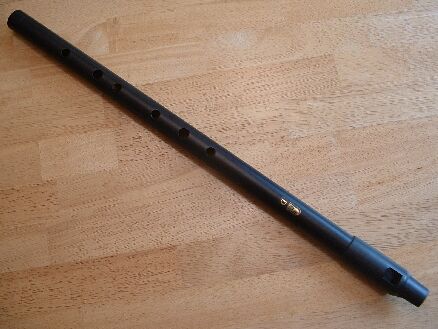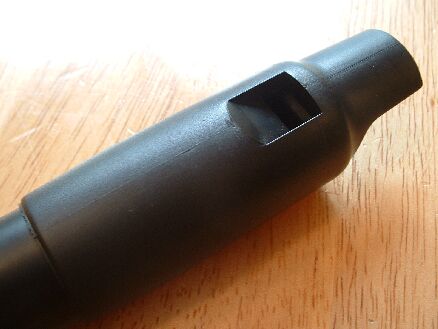Maker - Howard Music (Brian Howard) www.howardmusic.co.uk
Material - Brass Body with ABS Plastic Head
Dimensions: Length - 21 3/8ths" (with head pushed all the way in)
Distance between 1st and 3rd bottom holes - 2 15/16ths"
Diameter of 2nd hole from bottom - 7/16ths"
Bore - 1"
Weight - 6 oz
Price at time of review - 101.50 lbs direct from Maker, $135.00 US from distributor
I acquired this whistle by happy accident. I was searching ebay for a
copy of "The Low whistle Book" as I had lost my copy, when I came
across an auction for the book and this whistle in one lot.
Having intended to pay around $15 for the book, I ended up
getting a nice Low D for only $50 more. Howard's have had some very
mixed reviews in the past, and seem to have a reputation as a beginners
Low whistle, possibly due to it's relatively low price. Their head
joint has also gone through many versions/upgrades since the whistle
was first offered in 1985 (On an interesting side note, the first
Howard's were made in the early 1970's, just a few years after the
invention of the modern Low whistle. See the History
section for more). Some small research on my part indicated that the
whistle I acquired did not have the very latest version of the Head,
which was released in January of 2007.




Appearance: A
common nickname for the Howard Low D is the "Generation on Steroids",
and there is certainly something about the plastic headpiece that just
looks, well, big. This particular whistles brass body has been anodized
black, making it what my goth friends would call "tragically hip".
Seriously though, the combination of the black body and black mouth
piece, along with the gold logo and hints of brass coming from the
inside and bottom of the body make for a visually striking whistle.
Howard Low D's are also available in a variety of other colors and
finishes. This whistle is shorter than most other Low D's, and when
looking at and holding the whistle, I would swear that it was thicker
as well. But measurements showed that while the bore itself was larger,
this was mostly due to the wall of the body being much thinner than
those of a typical aluminum Low whistle. The only other Low whistle I
have seen that has a similar construction is a Burke Vyper
(interestingly, the second octave of the Howard sounds very similar to
the overall tone of a Burke).
Tone: This whistle has what just might be the most interesting tone of any whistle I have played. The first octave has a distinctive, gravely and nasal tone, reminiscent of a bagpipe or other reed instrument. In contrast, the second octave is very sweet and pure. The whole whistle has a fairly large amount of chiff. I have been told that the newest version of the Howard head piece has toned down the low octave growl, which I feel would be a shame, but I will reserve judgment until I have the chance to play one.
Volume: I would describe the volume of this whistle as being medium/moderate in comparison to other Low D's I have played. It does, however, have the strongest/loudest/fullest low fundamental note of all the whistles I have yet played. It is also fairly well balanced in volume between octaves, which can be pretty uncommon in low whistles. One might be able to get away with playing this in a quiet/smaller session environment.
Backpressure/air requirement:This whistle has moderate to high backpressure, making for a relatively low air/breath requirement. However, one does have to blow pretty hard and/or concentrate on tightening ones embouchure to cleanly play the high A and B notes in the second octave. While this whistle may not require allot of air, it does demand good breath support.
Responsiveness: Ornaments can be executed without too much trouble, but do not sound as clean and crisp as I prefer. The whistle in general is also pretty temperamental, and will squawk if you're not careful with both your fingering and your breath control/support. This is the major reason the keeps me from suggesting it as an ideal beginners whistle (I have heard that the newest version of the Howard Head goes some ways in addressing these issues).
Clogging: I did not experience any clogging issues with this whistle, a possible benefit of the abs plastic head.
Tuning: The head of this whistle can be moved in and out to adjust the tuning, and a line has been etched around the body to supposedly indicate where it would best play in tune. However, I found that when I lined up the head with this mark, the whole whistle played about 25 cents sharp. I did manage to pull the head out significantly to get it mostly in to tune. All the notes were then pretty much spot on (give or take a cent) with only two exceptions, the F# in both octaves and the C# were slightly flat. The whistle played a perfect C natural with the standard OXXOOO fingering.
Sound clip: Coinnleach Glas an Fhomhair
Summary: I have to admit that I initially did not like this whistle when I first received it. Some of that was due to its temperament (indeed, for the first few days I couldn't even get it to play a second octave B), but I also think it had allot to do with just how different it sounds from other Low whistles. The sound has since grown on me exponentially, and I found that the whistle was tamable with practice, good breath support and just taking the time to get to know it's idiosyncrasies. Other positives include the nice fat fundamental, something I always look for in a whistle, and the balanced volume. These combined to help me over look the initial technical difficulties/learning curve. This whistle has gone from disposable to an excellent addition to my collection, as it is always good to have different tone colors to choose from. Now I am looking forward to acquiring not only a Low C Howard, but another Low D with the new version Head piece as well. I'm thinking metallic green. Four holes.

You can also find another excellent review of Howard Low D's here on the Chiff and Fipple Whistle Forum. For chronological accuracy, you may want to note that the "old head" whistle in that review is an older version than the one in this review, but the other "new head" mentioned is the latest 2007 version, and is newer than the one reviewed here.
Tone: This whistle has what just might be the most interesting tone of any whistle I have played. The first octave has a distinctive, gravely and nasal tone, reminiscent of a bagpipe or other reed instrument. In contrast, the second octave is very sweet and pure. The whole whistle has a fairly large amount of chiff. I have been told that the newest version of the Howard head piece has toned down the low octave growl, which I feel would be a shame, but I will reserve judgment until I have the chance to play one.
Volume: I would describe the volume of this whistle as being medium/moderate in comparison to other Low D's I have played. It does, however, have the strongest/loudest/fullest low fundamental note of all the whistles I have yet played. It is also fairly well balanced in volume between octaves, which can be pretty uncommon in low whistles. One might be able to get away with playing this in a quiet/smaller session environment.
Backpressure/air requirement:This whistle has moderate to high backpressure, making for a relatively low air/breath requirement. However, one does have to blow pretty hard and/or concentrate on tightening ones embouchure to cleanly play the high A and B notes in the second octave. While this whistle may not require allot of air, it does demand good breath support.
Responsiveness: Ornaments can be executed without too much trouble, but do not sound as clean and crisp as I prefer. The whistle in general is also pretty temperamental, and will squawk if you're not careful with both your fingering and your breath control/support. This is the major reason the keeps me from suggesting it as an ideal beginners whistle (I have heard that the newest version of the Howard Head goes some ways in addressing these issues).
Clogging: I did not experience any clogging issues with this whistle, a possible benefit of the abs plastic head.
Tuning: The head of this whistle can be moved in and out to adjust the tuning, and a line has been etched around the body to supposedly indicate where it would best play in tune. However, I found that when I lined up the head with this mark, the whole whistle played about 25 cents sharp. I did manage to pull the head out significantly to get it mostly in to tune. All the notes were then pretty much spot on (give or take a cent) with only two exceptions, the F# in both octaves and the C# were slightly flat. The whistle played a perfect C natural with the standard OXXOOO fingering.
Sound clip: Coinnleach Glas an Fhomhair
Summary: I have to admit that I initially did not like this whistle when I first received it. Some of that was due to its temperament (indeed, for the first few days I couldn't even get it to play a second octave B), but I also think it had allot to do with just how different it sounds from other Low whistles. The sound has since grown on me exponentially, and I found that the whistle was tamable with practice, good breath support and just taking the time to get to know it's idiosyncrasies. Other positives include the nice fat fundamental, something I always look for in a whistle, and the balanced volume. These combined to help me over look the initial technical difficulties/learning curve. This whistle has gone from disposable to an excellent addition to my collection, as it is always good to have different tone colors to choose from. Now I am looking forward to acquiring not only a Low C Howard, but another Low D with the new version Head piece as well. I'm thinking metallic green. Four holes.
You can also find another excellent review of Howard Low D's here on the Chiff and Fipple Whistle Forum. For chronological accuracy, you may want to note that the "old head" whistle in that review is an older version than the one in this review, but the other "new head" mentioned is the latest 2007 version, and is newer than the one reviewed here.